It seems that every month or so we find another planet with the “possibility” to hold life. We find super earths, or giant planets in the “habitable” zone and we instantly believe that we can live in this new planet OR we believe that there is possible life. But what if we could find planets that actually had some sort of life in them? A new trick discovered by astronomers at the European Southern Observatory allows them to discovery life on planets by simply looking at the light emitted off the planet. In their experiment, they were able to detect life on earth by simply looking at the light reflected from our moon.
The problem with our current methods of discovery of life is the fact that we can’t really look at a planet and see the ant size people or animals walking in the surface. Imagine looking at an ant hill from the top of the empire state building, even with binoculars you can’t really see the bugs walking around. Likewise, if you look at the earth from something as close as orbiting satellites, it’s not possible to detect us. But if you look at the earth and study the chemical signals, you can see exactly what kind of elements you can find on it’s surface. For example, earth has far more oxygen and methane than a planet without some sort of life in the surface.
This new technique is called Spectroscopy, we can now detect gases that scientists call biosignatures. The system involves breaking up the light signals that reflect off a planet and then reconstructing the colors to determine which elements are present in the planet. Think, burning copper on the fire and creating the color green, every element creates a specific color signature, the astronomers will be looking for Oxygen and other elements required for life.
While this can be hard for planets that are extremely far and circling stars that drown the actual planet’s light, it can still be studied effectively by exploiting the light reflected from the planet. The reflected light is polarized, while the light emitted from the star is not. When the light passes through the planet’s atmosphere, it is polarized in two ways. When it is reflected by the oceans and vegetation, and when the particles in the air change the color of the light. By looking at the polarized light, we can pinpoint exactly what is going on in the planet with great detail.
Michael F. Sterzik, Stefano Bagnulo, and Eric Palle revealed in an ESO statement that they have tried out this method of light reflection by studying the light reflected of our moon. They used the Very Large Telescope in Chile to measure the linear polarization spectra of earth shine… which just means the light that bounced from the earth onto the moon, then bounced from the moon back to space. In their research they discovered that the earth has clouds, it has vegetation, and it had oceans. This new technique works so well that they can actually tell cloud coverage at different times of the day, and even detect vegetation as small as 10 percent. Image credit to NASA






